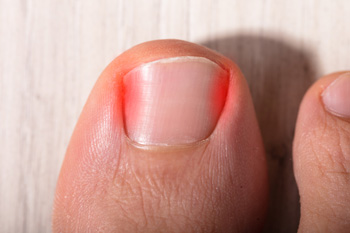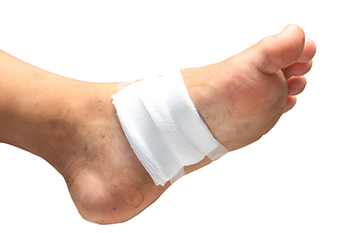Items filtered by date: September 2025
The Three Stages of Ingrown Toenails
 An ingrown toenail is a condition in which the sides or corners of a toenail dig into the surrounding skin. Ingrown toenails are classified into three stages based on their severity. In stage 1, the end of the toe becomes reddened and mildly swollen. The affected toe can feel warm and painful to the touch, but has no pus or drainage. In stage 2, the toe becomes increasingly red, swollen, and painful, with yellow or white pus draining from the area. An infection may develop. In stage 3, the redness and swelling increase even more, and a mass of new tissue can grow around the nail, adding even more swelling and more pus. At this stage, infections may be more severe and can be accompanied by a fever. If you have a painful or infected ingrown toenail, it is strongly recommended that you visit a podiatrist for treatment.
An ingrown toenail is a condition in which the sides or corners of a toenail dig into the surrounding skin. Ingrown toenails are classified into three stages based on their severity. In stage 1, the end of the toe becomes reddened and mildly swollen. The affected toe can feel warm and painful to the touch, but has no pus or drainage. In stage 2, the toe becomes increasingly red, swollen, and painful, with yellow or white pus draining from the area. An infection may develop. In stage 3, the redness and swelling increase even more, and a mass of new tissue can grow around the nail, adding even more swelling and more pus. At this stage, infections may be more severe and can be accompanied by a fever. If you have a painful or infected ingrown toenail, it is strongly recommended that you visit a podiatrist for treatment.
Ingrown toenails can become painful if they are not treated properly. For more information about ingrown toenails, contact Lesly Honore, MD, DPM of New York. Our doctor can provide the care you need to keep you pain-free and on your feet.
Ingrown Toenails
Ingrown toenails occur when a toenail grows sideways into the bed of the nail, causing pain, swelling, and possibly infection.
Causes
- Bacterial infections
- Improper nail cutting such as cutting it too short or not straight across
- Trauma to the toe, such as stubbing, which causes the nail to grow back irregularly
- Ill-fitting shoes that bunch the toes too close together
- Genetic predisposition
Prevention
Because ingrown toenails are not something found outside of shoe-wearing cultures, going barefoot as often as possible will decrease the likeliness of developing ingrown toenails. Wearing proper fitting shoes and using proper cutting techniques will also help decrease your risk of developing ingrown toenails.
Treatment
Ingrown toenails are a very treatable foot condition. In minor cases, soaking the affected area in salt or antibacterial soaps will not only help with the ingrown nail itself, but also help prevent any infections from occurring. In more severe cases, surgery is an option. In either case, speaking to your podiatrist about this condition will help you get a better understanding of specific treatment options that are right for you.
If you have any questions, please feel free to contact our office located in Hempstead, NY . We offer the newest diagnostic and treatment technologies for all your foot care needs.
Common Newborn Foot Deformities Explained

Newborns may have foot deformities that can affect growth and mobility if not addressed early. Metatarsus adductus is a condition where the front of the foot turns inward, often caused by the baby’s position in the womb, leading to visible curvature. Calcaneovalgus occurs when the foot points upward and outward due to intrauterine positioning, causing stiffness and difficulty with normal foot placement. Additionally, clubfoot causes the feet to turn inward. Symptoms of these conditions may include abnormal foot shape, limited flexibility, or uneven wear as a child begins to walk. A podiatrist can evaluate the severity, recommend stretching exercises, provide casting if necessary, and guide parents in treatment. If your newborn shows signs of a foot deformity, it is suggested that you include a podiatrist on your healthcare team who can provide effective management solutions.
Congenital foot problems require immediate attention to avoid future complications. If you have any concerns, contact Lesly Honore, MD, DPM of New York. Our doctor can provide the care you need to keep you pain-free and on your feet.
Congenital foot problems are deformities affecting the feet, toes, and/or ankles that children are born with. Some of these conditions have a genetic cause while others just happen. Some specific foot ailments that children may be born with include clubfeet, polydactyly/macrodactyly, and cleft foot. There are several other foot anomalies that can occur congenitally. What all of these conditions have in common is that a child may experience difficulty walking or performing everyday activities, as well as trouble finding footwear that fits their foot deformity. Some of these conditions are more serious than others. Consulting with a podiatrist as early as possible will help in properly diagnosing a child’s foot condition while getting the necessary treatment underway.
What are Causes of Congenital Foot Problem?
A congenital foot problem is one that happens to a child at birth. These conditions can be caused by a genetic predisposition, developmental or positional abnormalities during gestation, or with no known cause.
What are Symptoms of Congenital Foot Problems?
Symptoms vary by the congenital condition. Symptoms may consist of the following:
- Clubfoot, where tendons are shortened, bones are shaped differently, and the Achilles tendon is tight, causing the foot to point in and down. It is also possible for the soles of the feet to face each other.
- Polydactyly, which usually consists of a nubbin or small lump of tissue without a bone, a toe that is partially formed but has no joints, or an extra toe.
- Vertical talus, where the talus bone forms in the wrong position causing other bones in the foot to line up improperly, the front of the foot to point up, and the bottom of the foot to stiffen, with no arch, and to curve out.
- Tarsal coalition, when there is an abnormal connection of two or more bones in the foot leading to severe, rigid flatfoot.
- Cleft foot, where there are missing toes, a V-shaped cleft, and other anatomical differences.
- Macrodactyly, when the toes are abnormally large due to overgrowth of the underlying bone or soft tissue.
Treatment and Prevention
While there is nothing one can do to prevent congenital foot problems, raising awareness and receiving neonatal screenings are important. Early detection by taking your child to a podiatrist leads to the best outcome possible.
If you have any questions, please feel free to contact our office located in Hempstead, NY . We offer the newest diagnostic and treatment technologies for all your foot care needs.
Proper Care Is Essential for Puncture Wounds

Puncture wounds in the feet may appear minor at first, but they require prompt professional attention because of the risk for serious complications. Puncture wounds are commonly caused by stepping on objects like nails, glass, or thorns, while barefoot or wearing flip-flops that allow penetration. The depth and location of the wound play a major role in determining possible damage, which may include harm to tendons, ligaments, or joints. Infections such as cellulitis or abscesses can develop, and in some cases, a bone infection known as osteomyelitis may occur. Symptoms might not always be immediate, as some patients notice worsening pain, swelling, or drainage days to weeks after the initial injury. A podiatrist can assess the wound thoroughly, order imaging to check for foreign bodies, and provide treatment that may include wound care, antibiotics, or surgery to prevent further complications. If you have a puncture foot wound, it is suggested that you make an immediate appointment with a podiatrist for a diagnosis and treatment.
Wound care is an important part in dealing with diabetes. If you have diabetes and a foot wound or would like more information about wound care for diabetics, consult with Lesly Honore, MD, DPM from New York. Our doctor will assess your condition and provide you with quality foot and ankle treatment.
What Is Wound Care?
Wound care is the practice of taking proper care of a wound. This can range from the smallest to the largest of wounds. While everyone can benefit from proper wound care, it is much more important for diabetics. Diabetics often suffer from poor blood circulation which causes wounds to heal much slower than they would in a non-diabetic.
What Is the Importance of Wound Care?
While it may not seem apparent with small ulcers on the foot, for diabetics, any size ulcer can become infected. Diabetics often also suffer from neuropathy, or nerve loss. This means they might not even feel when they have an ulcer on their foot. If the wound becomes severely infected, amputation may be necessary. Therefore, it is of the upmost importance to properly care for any and all foot wounds.
How to Care for Wounds
The best way to care for foot wounds is to prevent them. For diabetics, this means daily inspections of the feet for any signs of abnormalities or ulcers. It is also recommended to see a podiatrist several times a year for a foot inspection. If you do have an ulcer, run the wound under water to clear dirt from the wound; then apply antibiotic ointment to the wound and cover with a bandage. Bandages should be changed daily and keeping pressure off the wound is smart. It is advised to see a podiatrist, who can keep an eye on it.
If you have any questions please contact our office located in Hempstead, NY . We offer the newest diagnostic and treatment technologies for all your foot and ankle needs.
When Foot Pain Strikes Suddenly

Gout is a form of arthritis that often affects the joints in the feet, particularly the big toe. Symptoms typically appear suddenly, often at night, and include intense pain, swelling, redness, and warmth in the affected joint. The area may appear shiny and feel extremely tender, even to the touch of a bedsheet. Gout is caused by a buildup of uric acid in the blood, which forms sharp crystals in the joints. Common triggers include diets high in red meat or seafood, excessive alcohol, dehydration, and genetic factors. A podiatrist can diagnose gout through a physical exam, a review of symptoms, and possibly blood tests or joint fluid analysis. Treatment may involve anti-inflammatory medications, dietary changes, lifestyle advice, and, in some cases, medication to reduce uric acid levels. A podiatrist can also help manage recurring flare-ups and long-term joint health. If you are experiencing these symptoms, it is suggested that you schedule an appointment with a podiatrist for appropriate relief and treatment solutions.
Gout is a painful condition that can be treated. If you are seeking treatment, contact Lesly Honore, MD, DPM from New York. Our doctor will treat your foot and ankle needs.
What Is Gout?
Gout is a form of arthritis that is characterized by sudden, severe attacks of pain, redness, and tenderness in the joints. The condition usually affects the joint at the base of the big toe. A gout attack can occur at any random time, such as the middle of the night while you are asleep.
Symptoms
- Intense Joint Pain - Usually around the large joint of your big toe, and it most severe within the first four to twelve hours
- Lingering Discomfort - Joint discomfort may last from a few days to a few weeks
- Inflammation and Redness -Affected joints may become swollen, tender, warm and red
- Limited Range of Motion - May experience a decrease in joint mobility
Risk Factors
- Genetics - If family members have gout, you’re more likely to have it
- Medications - Diuretic medications can raise uric acid levels
- Gender/Age - Gout is more common in men until the age of 60. It is believed that estrogen protects women until that point
- Diet - Eating red meat and shellfish increases your risk
- Alcohol - Having more than two alcoholic drinks per day increases your risk
- Obesity - Obese people are at a higher risk for gout
Prior to visiting your podiatrist to receive treatment for gout, there are a few things you should do beforehand. If you have gout you should write down your symptoms--including when they started and how often you experience them, important medical information you may have, and any questions you may have. Writing down these three things will help your podiatrist in assessing your specific situation so that he or she may provide the best route of treatment for you.
If you have any questions, please feel free to contact our office located in Hempstead, NY . We offer the newest diagnostic and treatment technologies for all your foot care needs.
Gout Pain Can Be Managed
Yoga Poses to Help Relieve Plantar Fasciitis

Plantar fasciitis is a common cause of heel pain that can make daily movement difficult. Gentle yoga poses can stretch and strengthen the feet to ease discomfort and promote healing. The upward salute lengthens the body while stretching the arches, and is done by standing up straight, pressing the heels into the ground, and raising your arms above your head. Chair pose builds strength in the legs and feet. This is done by turning your palms to face back, followed by sitting down as if you are sitting in a chair. High lunge, also known as Warrior I, improves flexibility in the calves and Achilles tendon, reducing strain on the plantar fascia. This is practiced by standing with one leg bent at the knee, while straightening the other in back, and raising both hands above your head. Such exercises can be a complement to professional treatment offered by a podiatrist in achieving long-term relief. If you are struggling with heel pain, it is suggested that you consult a podiatrist who can diagnose and treat symptoms of plantar fasciitis.
Stretching the feet is a great way to prevent injuries. If you have any concerns with your feet consult with Lesly Honore, MD, DPM from New York. Our doctor will assess your condition and provide you with quality foot and ankle treatment.
Stretching the Feet
Stretching the muscles in the foot is an important part in any physical activity. Feet that are tight can lead to less flexibility and make you more prone to injury. One of the most common forms of foot pain, plantar fasciitis, can be stretched out to help ease the pain. Stretching can not only ease pain from plantar fasciitis but also prevent it as well. However, it is important to see a podiatrist first if stretching is right for you. Podiatrists can also recommend other ways to stretch your feet. Once you know whether stretching is right for you, here are some excellent stretches you can do.
- Using a foam roller or any cylindrical object (a water bottle or soda can will do), roll the object under your foot back and forth. You should also exert pressure on the object. Be sure to do this to both feet for a minute. Do this exercise three times each.
- Similar to the previous one, take a ball, such as a tennis ball, and roll it under your foot while seated and exert pressure on it.
- Grab a resistance band or towel and take a seat. If you are using a towel, fold it length wise. Next put either one between the ball of your foot and heel and pull with both hands on each side towards you. Hold this for 15 seconds and then switch feet. Do this three times for each foot.
- Finally hold your big toe while crossing one leg over the other. Pull the toe towards you and hold for 15 seconds. Once again do this three times per foot.
It is best to go easy when first stretching your foot and work your way up. If your foot starts hurting, stop exercising and ice and rest the foot. It is advised to then see a podiatrist for help.
If you have any questions please contact our office located in Hempstead, NY . We offer the newest diagnostic and treatment technologies for all your foot and ankle needs.

